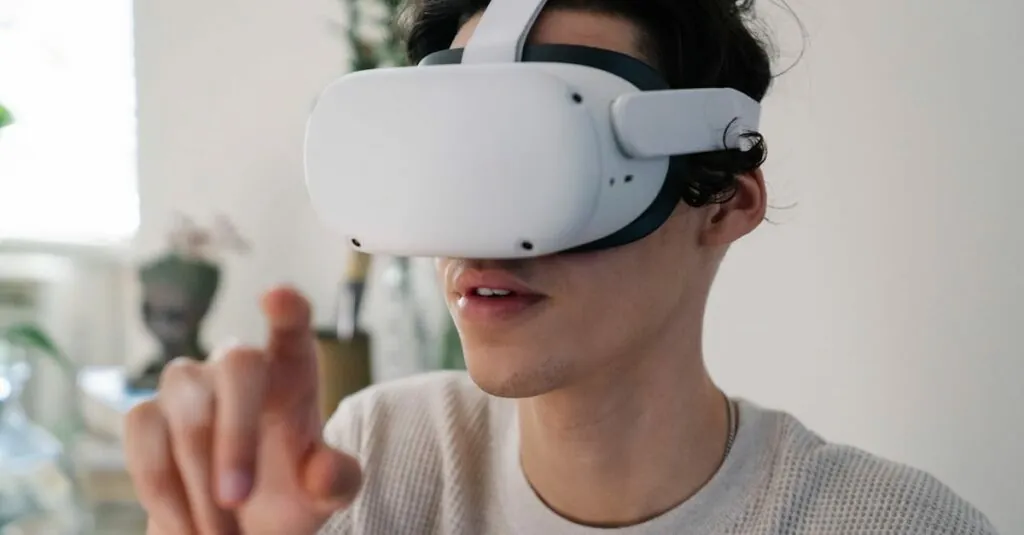Table of Contents
ToggleImagine reaching for a snack and suddenly your bag of chips starts telling you its life story. That’s the magic of augmented reality packaging. This innovative approach is transforming the way brands engage with consumers, turning mundane grocery runs into interactive adventures.
Gone are the days of boring labels and static information. With augmented reality, packaging becomes a portal to a world of immersive experiences. Whether it’s a playful game or a behind-the-scenes look at product sourcing, brands are finding creative ways to capture attention and build loyalty.
Overview of Augmented Reality Packaging
Augmented reality packaging leverages digital technology to enhance product interaction. This method allows consumers to experience more than traditional packaging provides. Instead of just reading labels, shoppers can engage with dynamic content through their smartphones or tablets.
Integration of augmented reality into packaging creates a new dimension of brand storytelling. Brands can embed videos, animations, or games into their packaging, which reinforces their marketing message. Shoppers receive a more immersive experience, learning about product features and sourcing in a compelling way.
Research indicates that 70% of consumers are more likely to engage with a product that features augmented reality. This engagement contributes to increased brand awareness and consumer loyalty. Brands such as Coca-Cola and Heineken exemplify the successful use of this technology, providing interactive experiences that resonate with customers.
Implementation of augmented reality technology in packaging also promotes social sharing. Consumers often share their experiences on social media, amplifying reach and engagement at little to no cost for the brand. This sharing not only cultivates community but also attracts new customers intrigued by the interactive features.
Augmented reality packaging transforms product labels into engaging experiences. The blend of digital and physical elements enhances consumer interaction, benefiting both brands and shoppers. As technology advances, this innovative approach will shape the future of consumer engagement in retail.
Benefits of Augmented Reality Packaging
Augmented reality packaging offers substantial advantages for brands and consumers alike. This innovative approach significantly boosts how brands connect with their audience.
Enhanced Customer Engagement
Engagement improves as consumers interact with augmented reality packaging. They experience dynamic content that transforms traditional shopping into an exciting journey. Actions like scanning a product lead to interactive games, detailed product information, or immersive storytelling. This heightened involvement fosters a deeper emotional connection to the brand. Data indicates that 70% of consumers find augmented reality experiences appealing, increasing the likelihood of purchase decisions. Engaging experiences encourage repeat visits, enhancing customer loyalty. Ultimately, creating memorable interactions drives a strong two-way relationship between brands and consumers.
Improved Brand Recognition
Recognition strengthens through the captivating nature of augmented reality packaging. Brands utilizing this technology stand out on crowded shelves. Unique visual elements and immersive content capture shopper attention effectively. Consumers often remember experiences linked to augmented reality, enhancing brand recall. Notably, brands like Coca-Cola and Heineken successfully exemplify this impact. They utilize interactive components that create memorable encounters. Research underscores that brands employing augmented reality witness increased awareness. Enhanced recognition leads to informed purchasing choices, directly impacting sales and brand loyalty.
Technologies Behind Augmented Reality Packaging
Augmented reality packaging relies on several key technologies that enhance consumer interaction and elevate brand experiences.
Mobile Applications
Mobile applications serve as the primary interface for augmented reality experiences. Consumers download these apps to unlock interactive content linked to packaging. Through intuitive designs, these apps guide users in scanning products to access immersive features. Recent research shows that 70% of consumers engage more with brands that offer mobile AR experiences. Popular applications bring packaging to life with videos, games, and detailed product information, amplifying brand storytelling.
QR Codes and Image Recognition
QR codes and image recognition technologies facilitate seamless interactions between products and consumers. Brands integrate QR codes into their packaging, allowing instant access to digital content when scanned. This method streamlines the engagement process, capturing attention quickly. Image recognition further enhances these experiences by allowing consumers to interact with the packaging itself. Data indicates that experiences triggered by QR codes drive consumer interest, making products more memorable and promoting brand loyalty.
Case Studies of Successful Implementation
Numerous brands effectively leverage augmented reality packaging to enhance consumer engagement. These innovative strategies create interactive experiences that significantly boost brand loyalty.
Innovative Brands in Augmented Reality Packaging
Coca-Cola stands out with its dynamic packaging that invites users to explore a virtual world through mobile devices. Heineken also utilizes augmented reality to provide beer enthusiasts with an exciting way to learn about their products. These brands incorporate elements such as games and informative videos, reinforcing their marketing messages and engaging consumers. Unilever’s Sunlight brand has seen success by allowing customers to interact with environmentally friendly messages through AR. Other brands, like Nestlé, use augmented reality to tell product sourcing stories, significantly elevating consumer interest.
Consumer Response and Feedback
Consumer feedback supports the effectiveness of augmented reality packaging. Research shows that 70% of consumers are more likely to engage with products featuring these technologies. Shoppers express excitement about the interactive elements, often sharing their experiences on social media platforms. This enthusiasm leads to increased brand recognition and recall. Many users report a stronger connection to brands that offer engaging AR experiences. Such positive responses enhance customer loyalty and drive repeat purchases, solidifying the benefits of innovative packaging solutions in the marketplace.
Challenges and Considerations
Augmented reality packaging faces several challenges that brands must address for successful implementation. Key areas include technical limitations and financial resources.
Technical Limitations
Augmented reality experiences depend on advanced technology, which can be a barrier. Consumers require smartphones or tablets with specific hardware and software capabilities. Compatibility issues arise with older devices that may not support the latest AR features. Some AR applications also consume significant battery power, decreasing user satisfaction. Connectivity speeds play a vital role in enabling smooth experiences; slow internet can disrupt interactions. Ensuring a seamless experience across various devices remains essential to maintaining consumer engagement.
Cost and Resources
Implementing augmented reality packaging entails significant investment. Developing interactive content involves costs for design, software development, and testing, which can be prohibitive for small brands. Brands must allocate budget for continuous updates to keep content fresh and relevant. Expertise in AR technology is critical; hiring skilled professionals can further stretch budgets. Additionally, brands may need to invest in marketing efforts to raise consumer awareness about AR features. Balancing innovation with budget limitations often requires strategic planning to maximize return on investment while delivering engaging experiences.
Augmented reality packaging is revolutionizing how brands connect with consumers. By transforming ordinary labels into interactive experiences, brands can foster deeper engagement and loyalty. This innovative approach not only enhances brand recognition but also encourages social sharing, amplifying reach at little cost.
As technology continues to evolve, AR packaging will likely become a standard in retail, creating memorable shopping experiences that resonate with consumers. Brands that embrace this trend will not only stand out on crowded shelves but also cultivate lasting relationships with their audience. The future of consumer engagement is bright with augmented reality leading the way.




